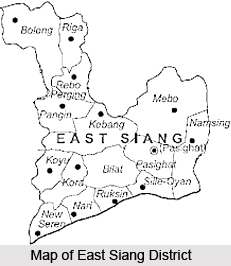 East Siang District is one of the district of Arunachal Pradesh, is remarkable to the tourists for the natural beauty. The presentable topography takes an artist to paint the landscape beauty of cloud capped mountains and the green coniferous forests.
East Siang District is one of the district of Arunachal Pradesh, is remarkable to the tourists for the natural beauty. The presentable topography takes an artist to paint the landscape beauty of cloud capped mountains and the green coniferous forests.
Geography of East Siang District
East Siang District is a wild mountainous area covered with Eastern Himalayas and the green forestry. East Siang District has an area of 4005 sq. km. The latitudinal extent of this district is approximately between 27 degree and 43 minutes and 29 degree and 20 minutes North latitudes and 94 degree and 42 minutes and 95 degree and 35 minutes East latitudes. East Siang District took its name from the mighty river of Arunachal Pradesh, named Siang River. This river is basically called as Tsangpo River which is sourced from Tibet. Tsangpo River transcends down and flows through the entire length of the area until it descends down into the plains of Assam south of Pasighat town, where it meets Dihang District and Lohit District and after that becomes the Brahmaputra River , as it entered in India.
People of East Siang District
The district of East Siang is mostly populated by the Adi tribe. This tribe comprised of a large number of tribal groups, which can be divided into various subgroups such as the Minyong Tribe, Padam Tribe, Shimong Tribe, Milang Tribe, Pasis Tribe, Karkos Tribe, Ashings Tribe, Pangis Tribe, Tangmas Tribe and Boris Tribe. The Adi tribal community belongs to the Astro-Mongolide race. The languages spoken in East Siang District are put together under the North-Assam group of the Tibeto-Burmese group.
Culture of East Siang District
The social structure of East Siang District, like most parts of Arunachal Pradesh is organized on the basis of clan. The social relationships in Adi Tribe are determined on the basis of kinship or locality. The family, called Rutum, is the smallest social entity. The society of the Adi Tribe in Arunachal Pradesh is patriarchal type. The sons inherit the property. One outstanding feature of the Adi tribal society that sets it aside from the mainland is the absence of the caste system. Among this tribal community there are some social distinctions, but all people eat together on social occasion and take their part in social councils. The tribal dances of Adi are an integral part of the lives of the people of East Siang District. Some of the famous dances are Ponung Dance, Popir dance, Dishang dance and Tapu dance.
Administration of East Siang District
The administration of this district is dependant on the Local Self Government called Kebang. These village councils are time-honoured socio-political institutions deriving their authority from tradition. They function as village governments expressing the will and power of the members of the society. The functions of these Kebangs are three- fold - judicial, administrative and developmental. Pasighat town, the headquarter of the East Siang District, which is situated at an altitude of 155 metres above main sea level. This is the oldest town in Arunachal Pradesh, established in the year 1911.






